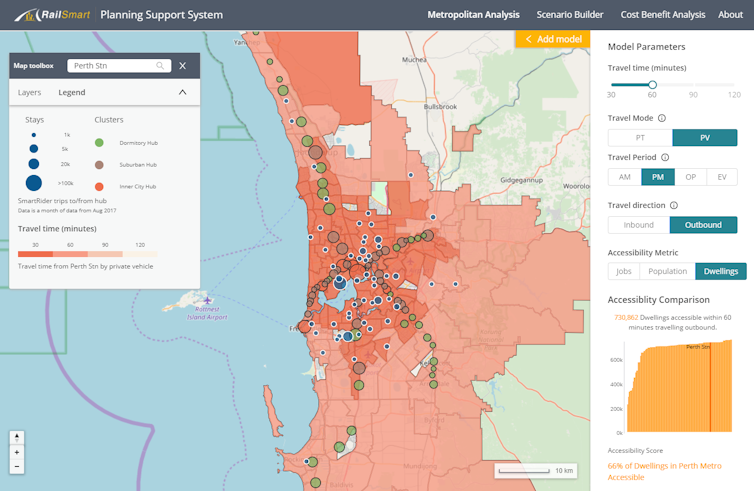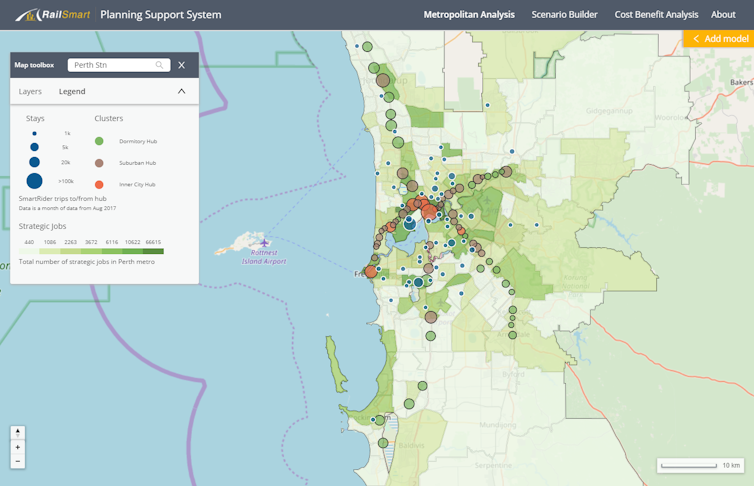 Analysing big data can tell us how a big city ticks, including where suitable housing and jobs are, and how best to get to them.LIPING/Shutterstock
Analysing big data can tell us how a big city ticks, including where suitable housing and jobs are, and how best to get to them.LIPING/ShutterstockThanks to the media, more people now know that you have to protect your personal data from being misused for commercial gains. Many of you are probably more conscious of what to share on Facebook or Instagram than you were two to three years ago. But, when used appropriately, data can be a great resource that informs urban management and planning.
For example, the RailSmart Platform, a Smart Cities 2019 award winner last Thursday, integrates numerous sets of data from the Australian Bureau of Statistics and other data sets such as the public transport ticketing system to work out how the city of Perth functions and how people move around.
Typically, people want to know what areas they can afford that best suit their work and travel requirements. You can use this platform to find out about house prices by location, travel times, locations of strategic jobs and how to get to them.
When you look up the locations of businesses you can see which train stations or major bus stops provide easy access to jobs. If you know the types of jobs, then you will also know whether those jobs are strategic jobs – jobs that create and attract other jobs. If you also look at real estate data, you can then find out the property values and rental prices of nearby properties.
To create this platform, we analysed the big data for Perth and visually represented what we found. To make this information accessible, we created a user-friendly digital mapping interface to display the modelled data.
So what sort of data are we talking about?
Read more: Explainer: what is big data?
Property values
House prices are one of the key economic indicators that people often pay attention to. Average house prices in Australian capital cities are easy to find, but what about more location-specific prices? You may be renting at the moment and thinking of moving elsewhere, or you may be a prospective property buyer.
Using real estate data, we have mapped the values of properties in different locations. For example, we can show you the number of different types of properties sold (e.g. house, unit, land and other types) and the average sale price of those properties. We can also show the rental values of different locations.
Read more: We need to talk about the data we give freely of ourselves online and why it's useful
Access to where people live
Ever wondered how good (or bad) your local road network is? How about your local public transport? The app can help you with this too.
Using the road network, the public transport network and the timetable data, we have mapped how accessible train stations and major bus stops are to houses, units and apartments. Based on prior research, the tool maps and models real-time analysis of accessibility to people, houses or jobs.
For example, we can show the locations you can get to from a specific train station using your own car or public transport on a map. Our data show that 66% of all dwellings in Perth can be accessed within 60 minutes using a private vehicle from Perth station.
 Accessibility of Perth station to dwellings – dark red areas show dwellings that can be reached within 30 minutes.RailSmart
Accessibility of Perth station to dwellings – dark red areas show dwellings that can be reached within 30 minutes.RailSmartRead more: Here's what smart cities do to stay ahead
Locations of ‘strategic’ jobs
Strategic jobs include jobs in IT and in academia. For planning purposes, you want to have more strategic jobs that will attract and create more employment.
We can show where strategic jobs are located on a map. In other words, we can show you the locations where you can expect to see more jobs concentrated and created.
 Strategic job locations – dark green areas show where more strategic jobs are located.RailSmart
Strategic job locations – dark green areas show where more strategic jobs are located.RailSmartLooking at two maps, the access to jobs and the strategic job locations, we can see that only limited strategic jobs can be accessed from Joondalup station.
The power of data
Some of you may be wondering how and where we got all these data. Is the dystopian world created by George Orwell in his fictional work Nineteen Eighty-Four coming true, with “Big Brother” watching your every move?
Fear not. The RailSmart analysis does not use any personalised data and all the data sets we used can be freely accessed by anyone.
The platform relies on aggregated data. This means it uses groupings of data or user types – for example, students, or geographic areas such as suburbs. It is impossible to tell what an individual is doing or even the sale price of individual properties; the platform represents trends as patterns of users and areas.
What makes the platform so powerful is when a set of data that seems unimportant is analysed along with another set of data and all of a sudden the two sets of data actually indicate something of significance.
Vist RailSmart and see the power of big data (login required, free to sign up).
Dr Sae Chi works for Planning and Transport Research Centre (PATREC) at the University of Western Australia. This work was undertaken as part of the RailSmart Wanneroo Project, which has received grant funding from the Australian government under the Smart Cities and Suburbs Program.
Dr Linda Robson works for Planning and Transport Research Centre (PATREC) at the University of Western Australia. This work was undertaken as part of the RailSmart Wanneroo Project, which has received grant funding from the Australian government under the Smart Cities and Suburbs Program.
Authors: Sae Chi, Research Associate at Planning and Transport Research Centre (PATREC), University of Western Australia
| < Prev | Next > |
|---|








